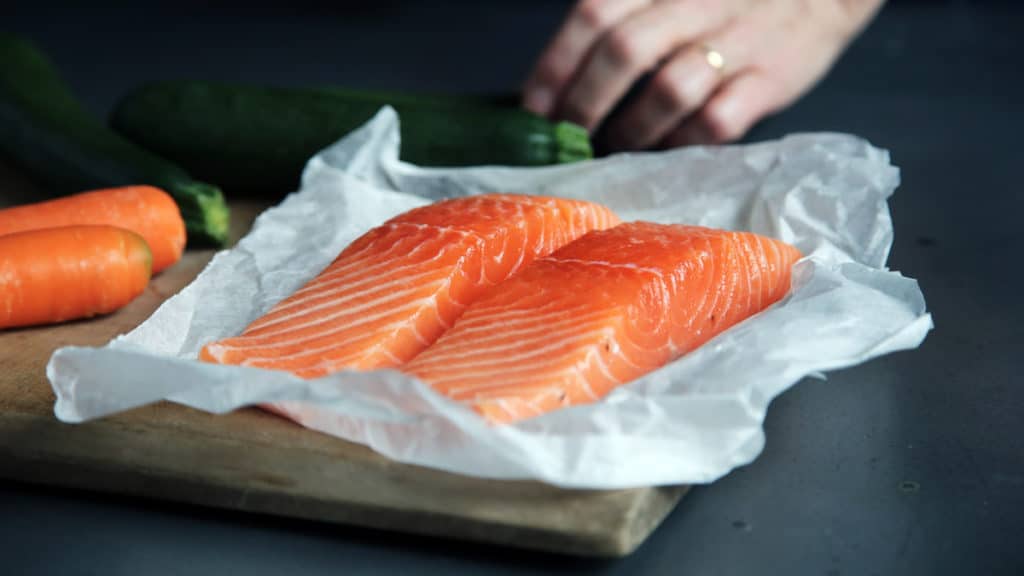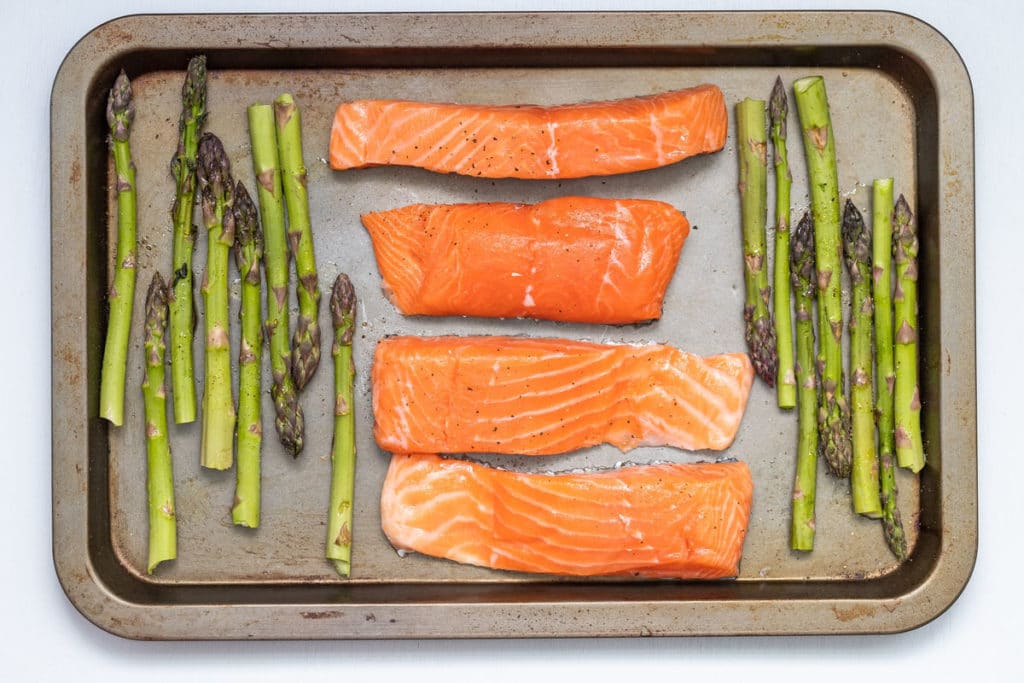
Ready to have a nice salmon dinner and have some pieces sitting in the freezer? Before you get them ready to be cooked, they are are going to have to be thawed out.
So, if you are here, you are probably wondering what is the best and quickest way to defrost salmon?
This article will look at 3 best options you can use to thaw salmon quickly and safely.
Let’s jump right into it.
The Best Way to Quickly Thaw Salmon: 3 Best Options To Use

The process of thawing salmon fish fillet is not overly complicated. It is recommended that you use one of the following methods in order to achieve the best results:
- Overnight in the refrigerator
- The microwave
- A cold water bath
Before we take a detailed look at each option, below is a quick breakdown as to how long each defrosting method should take.
How Long Does It Take to Defrost Frozen Salmon?
The table below is a general guide for how long it will take to thaw a salmon fillet using each method. Keep in mind that these are estimated times, and the actual time may vary depending on the size and thickness of your fish fillet.
| Method | Defrosting Time | Storage Instructions |
|---|---|---|
| Overnight in the Refrigerator | 8-12 hours | Defrosted salmon can be stored up to 48 Hours in the refrigerator. |
| Cold-water Method | 15-60 Mins | Defrosted salmon can be stored up to 48 Hours in the refrigerator. |
| Microwave | 5-10 Mins | Cook Immediately. |
Let’s now take a look at each of these methods in more detail so you can decide which one is best for you.
How to Thaw Frozen Salmon Overnight in the Fridge (The Safest Thawing Method)
Thawing salmon overnight in the refrigerator is not the quickest option, but it is by far the safest. This method ensures that your salmon stays at a consistent, safe temperature throughout the defrosting process, which helps to preserve its quality and prevents the growth of harmful bacteria.
Instructions
- Remove the frozen salmon from the freezer and put it in a container.
- Place the container in the in the refrigerator to thaw out overnight.
You should place the salmon on the bottom shelf of the refrigerator for Food safety reasons. You do not want the juices to leak from a higher shelf and contaminate food in lower shelves below. - By the next day, the salmon should be fully defrosted and ready to be used.
Pros: Safest way to thaw salmon.
Cons: Takes time. If you are in a rush and need to quickly thaw a salmon filet, this is not the option to go with.
How to Thaw Salmon in the Microwave (The Quickest Thawing Method)
If you are in a rush and need to defrost frozen salmon quickly, while not 100% recommended, the microwave is by far the best method to use.
There are 2 reasons why it’s not 100% recommended. You could either:
- Cook the salmon which is not what you want. You just wanted to thaw it out, not cook it!
- While most microwaves have a defrost setting, there is a possibility it could lead to uneven thawing, which is a major food safety concern.
You need to be extra careful when using the microwave method when defrosting frozen salmon and make sure to check on it regularly.
Instructions
- Place the frozen salmon in a microwave-safe container. (You could also cover the container with a paper towel, as this absorbs excess moisture as the salmon defrosts.)
- Open the microwave and place the container with the salmon inside. Use the defrost setting of the microwave or use 30% power and zap the salmon for 1 minute.
Ideally, it will take 7-8 minutes per pound to thaw out the salmon, depending on the size of the fish and the power of the microwave. - Check to see if the salmon is defrosted. If not, repeat the process above in 2-3 minute intervals until they are fully defrosted. (Also check to ensure that you are not cooking the fish, only defrosting them)
- Once thawed out, use immediately.
How to Thaw Salmon in Cold Water? (Another Quick Thaw Method If You Have Time)

While not as quick as the microwave, using cold water is another option to consider if you want the quickly thaw salmon fishy, but only if you’re not in a rush.
With the cold water method, you can do it in two ways:
- Running The Fillets Under Cold Water
- Submerging the Fillets in Cold Water
Steps (Running Under Cold Water)
- Fill a container with cold water.
- If the salmon is already in vacuum sealed bags/packaging, you can take the frozen pieces and place them in a container and place under a faucet of running water.
- Let the water continuously run over the frozen pieces, constantly turning them in the process.
- After 5-10 minutes, the salmon pieces should thaw out and be ready to be used.
Please Note: This is not the method to use if you are big on conserving water.
Steps (Submerging in Cold Water)
- Fill a container with cold water.
- If the frozen salmon is already in vacuum sealed bags/packaging, you can take the frozen pieces and submerge them in the container with cold water.
- Let the frozen pieces of salmon sit in the cold water for a 10 minutes.
- Change the water and let the frozen salmon pieces sit for a couple more minutes.
- Check and repeat the process if you find that they are still frozen. You can let the fish sit for a couple minutes, till they are fully thawed.
Below is a quick video that shows you how to use the cold water method
Thawing Frozen Salmon FAQ
Below are a couple of frequently asked questions that we wanted to address when it comes to defrosting salmon.
Do You Have To Thaw Salmon Fish If You Have No Time?
No, you don’t HAVE to thaw salmon if you have no time. If you are in an absolute rush, you can cook salmon straight from frozen without thawing it first. It is quite safe to do so, but there are a few things you should keep in mind.
For starters, cooking frozen salmon will take about 50% longer than cooking thawed salmon. Additionally, the fish may not cook evenly all the way through and the texture could be a bit off.
If you do choose to cook frozen salmon, just be sure to cook it until the fish is cooked all the way through and has reached an internal temperature of 145 degrees Fahrenheit.
Can You Defrost Frozen Salmon on the Kitchen Counter?
The short answer is no, you should never thaw frozen salmon (or any other type of fish) on the countertop or in warm water. This is because defrosting fish at room temperature can cause bacteria to grow, which can lead to food poisoning.
So, if you find yourself in a situation where you need to thaw your wild caught salmon quickly, always use the methods we mentioned earlier.
How to Safely Defrost Salmon
While you have different options when it comes to thawing out your salmon, you need to be aware of the ‘Danger Zone’, especially if you plan on using the microwave or letting it sit in cold water for a couple of minutes to thaw out.
So what is the ‘Danger Zone’? The Danger Zone, According to the United States Department of Agriculture (USDA), is the range of temperatures 40 ° and 140 °F, where bacteria multiplies and grows quickly.
With an increase of harmful bacteria in your food, there is a possibility of bacterial food poisoning occurring.
How Long Is Salmon Good for After Thawing?
How long the salmon will last after it has thawed is dependent on if it was cooked or not. If the salmon was thawed for the purpose of cooking, then it will be good for another two to three days in the refrigerator. If you have leftover cooked salmon that has been thawed, it will be good for four to six days in the fridge.
Ideally, you should cook or eat the salmon within a day or two of thawing it to ensure the best flavor and quality.
Related: How to Thaw Frozen Shrimp
Wrapping it up
There are many options available to you if you are looking to defrost salmon properly and quickly.
Before letting them thaw out, please be aware of incorrect thawing, which could place the salmon in the danger zone and opens it up for the possibility of food borne bacteria.
Ideally, letting the salmon pieces sit in the refrigerator is the best way for them to thaw out, but the microwave/running under cold water are also viable options.